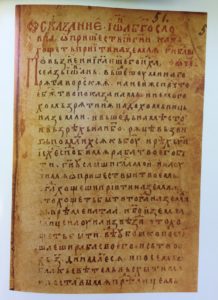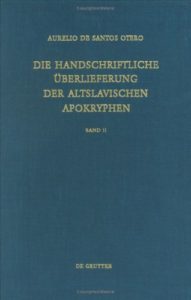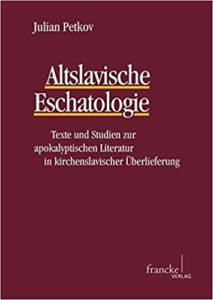Johannine Apocalyptica in Church Slavonic
For the second volume of New Testament Apocrypha: More Noncanonical Scriptures I decided to include as much information as possible on what we call “versions”—a term designating translations of the texts into other languages. Such attention is a given if the text is not available in its original language, but far too often in Christian apocrypha scholarship there is a neglect of those languages outside of Greek and Latin, and perhaps Coptic and Syriac, that few of us can claim some proficiency. One of these neglected language groups is Church Slavonic (CS). There are plenty of experts in Slavistics, and some work on Jewish and Christian apocrypha, but there seems to be little interaction between the two groups of scholars. Unfortunately, I have no training in the language nor its history but I am working on some texts for MNTA that are plentiful in CS manuscripts. So this past weekend I went to work with my frequent research partner Slavomír Céplö (whose language knowledge is enviable) to fill in the details about the CS tradition of four apocryphal Johannine apocalypses. The work was fruitful but frequently frustrating.

First, a little background on the texts. I described many of them in a previous post on erotapokriseis (question-and-answer) literature, but I will give some brief details here also. 1 Apocryphal Apocalypse of John, the most well-known of the texts, is a sequel of sorts to the canonical Revelation. Jesus appears to John on Mount Tabor and John asks him a series of questions on matters relating to eschatology, such as the timing of the return of Jesus and the breaking of the seven seals, and it also provides a description of the Antichrist. The entry on the text in MNTA 2 was written by Rick Brannan, but I have been adding bits and pieces to the introduction as I pick up more information on the CS tradition (and be sure to pick up a copy of Rick’s Greek Reader of the text; details HERE). The text has a rich Greek tradition; Constantin von Tischendorf drew on seven manuscripts for his edition (Apocalypses Apocryphae [Leipzig, 1866], 70–94), which is still the textus receptus) and another 27 are known to us). 2 Apocryphal Apocalypse of John (aka the Apocalypse of John Chrysostom) is another question-and-answer dialogue, though the identity of the interlocutor is not always clear (the title says John Chrysostom but the Greek manuscripts also call him “John the Theologian”). Regardless, the text is not extant in CS so it is not our concern here. 3 Apocryphal Apocalypse of John (sometimes called 4 Apocr. Apoc. John, if one counts the Questions of James to John as the third Johannine apocalypse) is a dialogue between John and Abraham about various issues relating to the afterlife (Do people remain married? What do they eat? etc.). Only two manuscripts in Greek exist, and these are quite difficult at times to read. Chance Bonar and I have prepared a synoptic translation of the two manuscripts for MNTA 2. CS sources for the text are plentiful and could be of much help in reconstructing portions of the Greek text that remain difficult. Finally, 3 Apocr. Apoc. John is often confused with a fourth text known only in CS: the Questions of John to Abraham. It has a bit of overlap with 3 Apocr. Apoc. John at the start of the text (John asks what the dead will eat in paradise), so the confusion of the two texts is natural if one reads only the incipits in manuscript catalogs, but the rest of the text deals exclusively with memorials for the dead.
 The go-to resource for CS apocrypha is Aurelio de Santos Otero’s Die handscriftliche Überlieferung der altslavischen Apokryphen published in two volumes in 1978 and 1981 (PTS 20 and 23; Berlin: de Gruyter). It is essentially a catalog of catalogs, listing all of the known manuscripts and providing a short summary of the texts. De Santos Otero writes here in German, with some transliteration of CS, so it is quite accessible to Western scholars who, for the most part, are able to read German, but not CS. De Santos Otero also provides information on the publication of manuscripts by Russian scholars in the late nineteenth and early twentieth centuries; some of this material is available online, though it can be tricky to find (sometimes de Santos Otero’s transliterated titles work in searches but some need to be entered in Cyrillic). Unfortunately, de Santos Otero’s work suffers from some pretty glaring errors. Francis J. Thomson, who published two scathing reviews of the volumes (vol. 1 in Slavonic and East European Review 58.2 [1980]: 256–68; vol. 2 in 63.1 [1985]:73–98), said of the first “he has produced a poorly ordered work whose errors of detail indicate superficial scanning rather than careful perusal of manuscript catalogues” (257) and of the second “the German Patristic Commission which gave this volume and its predecessor an imprimatur deserves better” (98). Anyone using de Santos Otero should read Thomson’s reviews and take note of the corrections he offers therein. But for all of Thomson’s indignation, he too makes errors.
The go-to resource for CS apocrypha is Aurelio de Santos Otero’s Die handscriftliche Überlieferung der altslavischen Apokryphen published in two volumes in 1978 and 1981 (PTS 20 and 23; Berlin: de Gruyter). It is essentially a catalog of catalogs, listing all of the known manuscripts and providing a short summary of the texts. De Santos Otero writes here in German, with some transliteration of CS, so it is quite accessible to Western scholars who, for the most part, are able to read German, but not CS. De Santos Otero also provides information on the publication of manuscripts by Russian scholars in the late nineteenth and early twentieth centuries; some of this material is available online, though it can be tricky to find (sometimes de Santos Otero’s transliterated titles work in searches but some need to be entered in Cyrillic). Unfortunately, de Santos Otero’s work suffers from some pretty glaring errors. Francis J. Thomson, who published two scathing reviews of the volumes (vol. 1 in Slavonic and East European Review 58.2 [1980]: 256–68; vol. 2 in 63.1 [1985]:73–98), said of the first “he has produced a poorly ordered work whose errors of detail indicate superficial scanning rather than careful perusal of manuscript catalogues” (257) and of the second “the German Patristic Commission which gave this volume and its predecessor an imprimatur deserves better” (98). Anyone using de Santos Otero should read Thomson’s reviews and take note of the corrections he offers therein. But for all of Thomson’s indignation, he too makes errors.
De Santos Otero gives information for 57 manuscripts of Johannine apocalyptica in vol. 1 and another five in vol. 2, though one of these, no. 61, is identical to no. 28. Otero’s list includes three separate texts: those that are clearly 1 Apocr. Apoc. John (25), those he lists as 3 Apocr. Apoc. John (16), and some he vaguely lists as “Questions of John to Abraham” (7), which could be either Quest. John Ab. or 3 Apocr. Apoc John. The remaining 13 are unspecified. Some of these manuscripts contain two of the texts, a few contain all three. The manuscript shelf numbers are current as of 1981; today, many of the names of the libraries and even the cities in which they are located, have changed, so almost all of the listings need to be updated. From de Santos Otero’s information, Slavomír and I found out that several manuscripts of Quest. John Ab. and 3 Apocr. Apoc John were published by in 1863 by Nikolai Tichonravov (Pamjatniki otrecennoj russkoj literatury [2 vols. Moscow: Obšcestv. Pol’za], available online HERE). Since Tichonravov is easily accessible, Slavomír used his editions to make translations of the two texts and we will these to the MNTA entry of 3 Apocr. Apoc John. We were getting somewhere.
But then I came across three recent works that complicate matters considerably. The first of these is Tomislav Jovanovic’s 2005 collection of CS apocrypha in Serbian translation: Apokrifi novozavetni (Belgrade: Prosveta). The collection includes a translation of 3 Apocr. Apoc. John. based on an edition of the text that predates Tichonravov’s (but not mentioned by de Santos Otero). This edition is found in a study of CS erotapokriseis litertature by Vasilij Mocul’skij: Sledy narodnoj biblii v slavjanskoj i drevnerusskoj pis ‘mennosti (Odessa, 1893). Mocul’skij also provides information on manuscripts for all three Johannine apocalyptica; many of these manuscripts are not found in de Santos Otero’s list. The corpus of 3 Apocr. Apoc. John. manuscripts is expanded further with several additional sources mentioned in the notes to Jovanovic’s translation.
 The second new study is a chapter dedicated to Johannine apocalyptica in Julian Petkov’s Altslavische Eschatologie: Texte und Studien zur apokalyptischen Literatur in kirchenslavischer Überlieferung (TANZ 59; Tübingen: Narr Francke Attempto, 2016). Once again, sources for all three texts are provided, this time correlating Moculskij’s and de Santos Otero’s lists (but not Jovanovic’s) and adding even more new manuscripts. As useful as Petkov’s work is, it too has problems: Petkov does not seem to be aware of Otero’s additions in vol. 2, nor of Thomson’s corrections, and he makes some errors of his own (including misidentification of texts).
The second new study is a chapter dedicated to Johannine apocalyptica in Julian Petkov’s Altslavische Eschatologie: Texte und Studien zur apokalyptischen Literatur in kirchenslavischer Überlieferung (TANZ 59; Tübingen: Narr Francke Attempto, 2016). Once again, sources for all three texts are provided, this time correlating Moculskij’s and de Santos Otero’s lists (but not Jovanovic’s) and adding even more new manuscripts. As useful as Petkov’s work is, it too has problems: Petkov does not seem to be aware of Otero’s additions in vol. 2, nor of Thomson’s corrections, and he makes some errors of his own (including misidentification of texts).
The third work is a hot-off-the-press essay by Anisssava Miltenova entitled “Apocalypsis Johannis apocrypha quarta (4 Ap. Apoc. John) in the Slavonic Tradition” (in The Embroidered Bible: Studies in Biblical Apocrypha and Pseudepigrapha in Honour of Michael E. Stone [ed. Lorenzo DiTommaso, Matthias Henze, and William Adler; Leiden: Brill, 2018], 686–717. Note that Miltenova calls the text 4 Apocr. Apoc. John; such variation in the titles just adds to the confusion in studying this material. Miltenova examines 19 South Slavic manuscripts, some used by previous scholars, some new. Unlike de Santos Otero and Petkov, Miltenova has personally examined the manuscripts, so her identification of their contents is likely to be reliable, and though she does not say so, the accessibility of these particular manuscript may be why she chose them for her study. Miltenova’s article includes an edition of one of these sources and an English translation—the first ever for this text. Her manuscript follows the Greek far more closely than Tichonravov’s, so it will be useful for settling some lingering questions about the Greek text; we will still include Slavomír’s translation of Tichonravov’s manuscript as an appendix, if for no other reason than to give readers a sense of how much the CS texts vary from one another. Miltenova’s work also has some deficiencies—some portions of her edition are mysteriously absent from her translation, and she is unaware of the contributions by Petkov and Jovanovic; she also makes no mention of Mocul’skij, though she is certainly aware of it as she includes it in some of her other work.
One last work is worth noting. Rick Brannan had already come across a study of 1 Apocr. Apoc. John by Javor Miltenov: “The Apocryphal Apocalypse of John the Theologian (Commentary and Critical Edition of the Text),” in Annuaire de l’Universite de Sofia “St. Kliment Ohridski” Faculte de Philologies Slaves, vols. 96–97 (Sofia: Presses Universitaires “St. Kliment Ohridski,” 2007), 91–167. Unfortunately, Miltenov writes in Bulgarian, so Rick took all of the information he could about the article from an English abstract published along with it. Ah, but Slavomír reads Bulgarian. The value of Miltenov’s work, besides an edition of 1 Apocr. Apoc. John based on the earliest CS source (Saint Petersburg, National Library of Russia, gr. 70, a portion of a palimpsest from St. Catherine’s Monastery), is a list of nine additional manuscripts used in his apparatus, four of which do not appear on the lists of de Santos Otero and Petkov.
So what are the results? I now have a large chart listing all of the manuscripts and their contents as described by the various scholars. Some of the discrepancies have been resolved, but others can only be settled by seeing the manuscripts themselves, either in person or online. Not all of this research will end up in the finished entries for MNTA 2 (I don’t think our readers need to see the complete list of manuscripts for each text), but it will be integrated into the entries on e-Clavis. Thomson’s critique of de Santos Otero’s work, along with the deficiencies I have noted here, makes it clear that an updated list of CS apocrypha manuscripts is needed, and hopefully some skilled Slavistics scholar with an interest in apocrypha will take up the challenge some time soon. I do hope more Christian apocrypha scholars will take the time to examine the CS sources for the texts that they study, and that there will be more opportunities to work with our colleagues in Slavistics.
